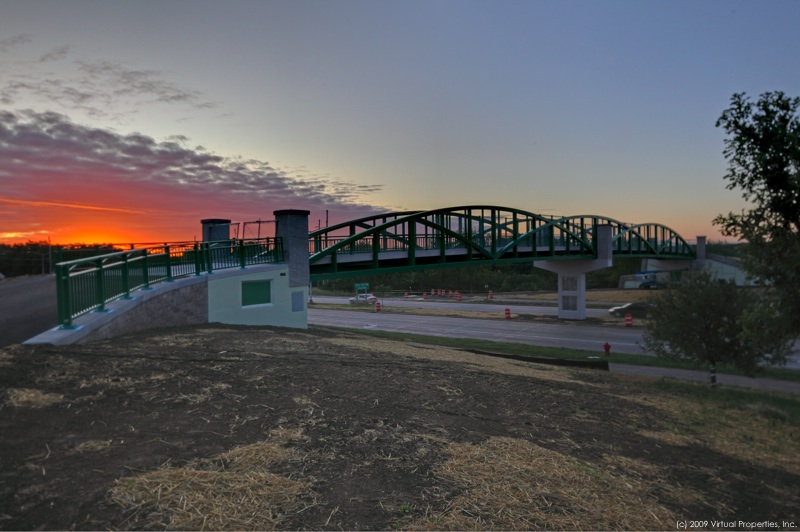
This photo was taken in downtown Madison.
Category: Current Events
Cropping Photos……
The Sept. 14th Newsweek cover line — “Is Your Baby Racist?” — should have included a sub-head, “Is Dick Cheney a Butcher?”
Featured inside the magazine was a full-page, stand-alone picture of former Vice President Dick Cheney, knife in hand, leaning over a bloody carving board. Newsweek used it to illustrate a quote that he made about C.I.A. interrogators. By linking that photo with Mr. Cheney’s comment and giving it such prominence, they implied something sinister, macabre, or even evil was going on there.
I took that photograph at his daughter Liz’s home during a two-day assignment, and was shocked by its usage. The meat on the cutting board wasn’t the only thing butchered. In fact, Newsweek chose to crop out two-thirds of the original photograph, which showed Mrs. Cheney, both of their daughters, and one of their grandchildren, who were also in the kitchen, getting ready for a simple family dinner.
However, Newsweek’s objective in running the cropped version was to illustrate its editorial point of view, which could only have been done by shifting the content of the image so that readers just saw what the editors wanted them to see. This radical alteration is photo fakery. Newsweek’s choice to run my picture as a political cartoon not only embarrassed and humiliated me and ridiculed the subject of the picture, but it ultimately denigrated my profession.
The Ghost Fleet of the Recession
The biggest and most secretive gathering of ships in maritime history lies at anchor east of Singapore. Never before photographed, it is bigger than the U.S. and British navies combined but has no crew, no cargo and no destination – and is why your Christmas stocking may be on the light side this year.
The tropical waters that lap the jungle shores of southern Malaysia could not be described as a paradisical shimmering turquoise. They are more of a dark, soupy green. They also carry a suspicious smell. Not that this is of any concern to the lone Indian face that has just peeped anxiously down at me from the rusting deck of a towering container ship; he is more disturbed by the fact that I may be a pirate, which, right now, on top of everything else, is the last thing he needs.
His appearance, in a peaked cap and uniform, seems rather odd; an o fficer without a crew. But there is something slightly odder about the vast distance between my jolly boat and his lofty position, which I can’t immediately put my finger on.
Then I have it – his 750ft-long merchant vessel is standing absurdly high in the water. The low waves don’t even bother the lowest mark on its Plimsoll line. It’s the same with all the ships parked here, and there are a lot of them. Close to 500. An armada of freighters with no cargo, no crew, and without a destination between them.
An Interesting Look at France & Great Britain During as the Wall Came Down…
The tensions that rocked the British government following the collapse of the Berlin Wall in 1989 are revealed in a series of Whitehall documents published today.
The papers throw fresh light on the struggle between Margaret Thatcher, prime minister at the time, and senior Foreign Office figures over German reunification.
As the Financial Times revealed yesterday, the documents show that Mrs (now Lady) Thatcher and François Mitterrand, the late French president, harboured fears that a united Germany would threaten Europe. They display the degree to which Mrs Thatcher clashed with Douglas Hurd, then foreign secretary, and Sir Christopher Mallaby, then ambassador to Bonn, who felt reunification was inevitable.
After Helmut Kohl, the West German chancellor, announced a 10-point plan for reunification on November 28, 1989, Mrs Thatcher expressed her opposition.
She told Mr Mitterrand in talks on December 8 that Mr Kohl had “no conception of the sensitivities of others in Europe, and seemed to have forgotten that the division of Germany was the result of a war which Germany had started”.
A separate memorandum by Charles Powell, her foreign policy adviser, underscores her opposition. “We do not want to wake up one morning and find that. . . German reunification is to all intents and purposes on us,” he wrote.
Medical Tourism Takes Flight
A growing number of U.S. insurers are paying for patients to have medical procedures performed more cheaply overseas. And that’s raising the profile of a few companies you’ve probably never heard of. Video: Bangkok Bypass Surgery
IN THE PAST THREE MONTHS, THE CREAKY Barron’s staff has replaced a hip, two knees and undergone various nips and tucks. Based on average prices, these cost a total of at least $100,000. But abroad, say in Singapore, the tab would have been about $50,000, including stays in a private room, airfare and a vacation for the patients and their companions. Elsewhere in Asia, medical care is even cheaper. That’s why more U.S. insurers are considering financing treatment for Americans willing to travel abroad. In fact, “medical tourism” could help rein in the health-care costs that devour 16% of America’s gross domestic product.
That possibility is raising the profile of a few publicly traded companies you’ve probably never heard of: Thailand’s Bumrungrad Hospital (ticker: BH.Thailand) and Bangkok Dusit Medical Services (BGH.Thailand), Singapore’s Parkway Holdings (PWAY.Singapore) and Raffles Medical (RFMD.Singapore), and India’s Apollo Hospitals (APHS.India). Says Prathap Reddy, the U.S.-trained cardiologist who founded Apollo in 1983 and is its chairman: “We bring excellent care at a cost benefit. If the U.S. were to cover all its people, there would be a demand/supply gap. India can step in with equivalent care at one-fifth the cost.”
Paranoid Survivor: Andrew Grove
EARLIER this year Andrew Grove taught a class at Stanford Business School. As a living legend in Silicon Valley and a former boss of Intel, the world’s leading chipmaker, Dr Grove could have simply used the opportunity to blow his own trumpet. Instead he started by displaying a headline from the Wall Street Journal heralding the recent takeover of General Motors by the American government as the start of “a new era”. He gave a potted history of his own industry’s spectacular rise, pointing out that plenty of venerable firms—with names like Digital, Wang and IBM—were nearly or completely wiped out along the way.
Then, to put a sting in his Schumpeterian tale, he displayed a fabricated headline from that same newspaper, this one supposedly drawn from a couple of decades ago: “Presidential Action Saves Computer Industry”. A fake article beneath it describes government intervention to prop up the ailing mainframe industry. It sounds ridiculous, of course. Computer firms come and go all the time, such is the pace of innovation in the industry. Yet for some reason this healthy attitude towards creative destruction is not shared by other industries. This is just one of the ways in which Dr Grove believes that his business can teach other industries a thing or two. He thinks fields such as energy and health care could be transformed if they were run more like the computer industry—and made greater use of its products.
Dr Grove may be 73 and coping with Parkinson’s disease, but his wit is still barbed and his desire to provoke remains as strong as ever. Rather than slipping off to a gilded retirement of golf or gallivanting, as many other accomplished men of his age do, he is still spoiling for a fight.
Documenting the decline of two US industries
Eirik Johnson’s quietly theatrical photographs carry the sense of a way of life and work that is on the cusp of slipping away. For four years, Seattle-born Johnson travelled through Oregon, Washington and northern California, around the former boomtowns that were built on the now-declining salmon and timber industries.
He describes the resulting series, published as Sawdust Mountain, as “a melancholy love letter of sorts, my own personal ramblings”. Many of Johnson’s works are informed by the epic, picturesque 19th-century landscapes of Carleton Watkins, who took some of the earliest known images of the region. In others, his use of space and colour pays homage to several living photographers.
Johnson’s images are rendered all the more intense by his palette, through which he uses the region’s faded light to emphasise the down-at-heel tones of the man-made environment. His muted colours are a counterpoint to William Eggleston’s photographs of the American south, whose “harsh bright light and colours … seemed like the mirror opposite of what I saw present in the northwest,” says Johnson.
Sunrise: Fitchburg’s New Pedestrian & Bicycle Bridge

A Not Positive Outlook on Land’s End Parent Sears Holdings
For many investors, the ultimate value of Sears resides in its liquidation value rather than the cash flow it can generate as a going concern. Much hidden value is seen in its valuable brands, like Kenmore, Land’s End, Craftsman and DieHard, and the 73% interest in Sears Canada. A major holder “conservatively” estimates the retailer’s breakup value at about $75 to $100 a share. (A confession: In an Oct. 22, 2007, article in Barron’s, I surmised that there might be more than $300 a share in hidden value in Sears stock.)
Given the recent performance of the company and the agonies of the U.S. consumer and credit markets, these sum-of-the-parts estimates have plummeted. In a May report, Morgan Stanley’s Greg Melich came up with a value of $33 a share. Last week, he said that the new value would be somewhat but not dramatically higher when he releases his latest calculations in the next few weeks.
Nonetheless, the entire exercise is somewhat academic, according to Melich. Sears, for example, couldn’t dump all its 250 million square feet of retail space without destroying the values of retailing properties for years to come. Likewise, who knows when shell-shocked mall-owning real-estate investment trusts and once-expansion-minded rivals like Target, Kohl’s and Lowe’s will be buying again, particularly with the current glut of space on the market and the drying up of mortgage financing. And the Kenmore, DieHard and Craftsman brands (but not Land’s End) are so closely identified with Sears that it’s difficult to ascribe much value to them if they are offered independent of Sears.
Flickr vs. Free Speech
One thing I’ve learned over the years is this – screwing over your users while yelling “the lawyers made me do it!” rarely ends well. Particularly when the lawyers are just being lazy, and free speech rights are at stake.
Flickr really stepped in it this time. And they’ve sparked a free speech and copyright fascism debate that is unlikely to cool down any time soon.
Sometime last week they took down a photoshopped image of President Obama that makes him look like the Heath Ledger (Joker) character from The Dark Knight. The image was created and uploaded to Flickr by 20 year old college student Firas Alkhateeb while “bored over winter school break.” It was also later altered yet again by someone else and used to create anti-obama posters that went up in Los Angeles.
Thomas Hawk has a good overview of some of the other details, but the short version is the image was removed by Flickr sometime last week due to “due to copyright-infringement concerns.”
People are angry over the takedown. There are lots of pictures mocking President Bush on a Time Magazine cover on Flickr that haven’t been removed. And of the Heath Ledger Joker character.
